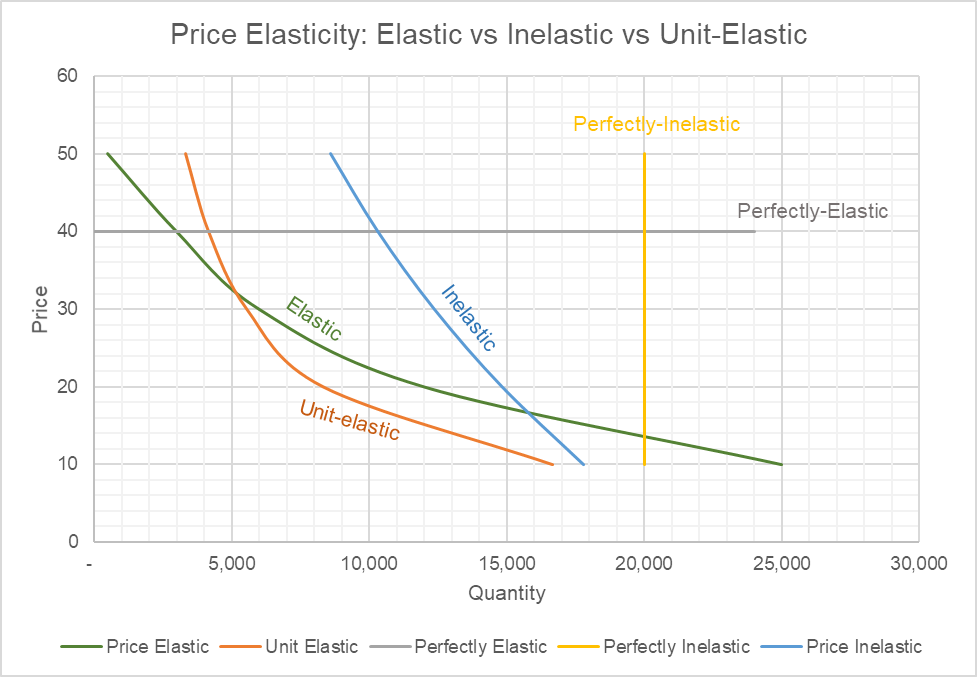Elastic vs Inelastic Demand
A product or service has elastic demand when its price elasticity of demand is greater than 1, unit-elastic when price elasticity is 1 and inelastic when the price elasticity is less than 1.
Price elasticity of demand measures the responsiveness of quantity demanded to change in price. It is calculated by dividing the percentage change in the quantity demanded by the percentage change in price. The percentage change is quantity demanded is calculated by dividing the difference between initial and final quantities by the average of both quantities. Similarly, percentage change in price equals the difference between final and initial price divided by the average of both prices.
The following formula can be used to calculate price elasticity:
$$ \text{E} _ \text{d}=\frac{\text{Q} _ \text{2}-\text{Q} _ \text{1}}{\frac{\text{Q} _ \text{2}+\text{Q} _ \text{1}}{\text{2}}}\div\frac{\text{P} _ \text{2}-\text{P} _ \text{1}}{\frac{\text{P} _ \text{2}+\text{P} _ \text{1}}{\text{2}}} $$
Where Q1 is the initial quantity demanded, P1 is the price that corresponds to Q1 and Q2 is the new quantity demanded after the price changes to P2.
Because quantity demanded decreases with increase in price, the above equation generally gives us a negative number. The negative sign is generally ignored, and the price elasticity is quoted as an absolute number i.e. as a positive number.
The following chart shows demand curves for different levels of price elasticity:

Elastic Demand
Demand is considered elastic when the absolute value of price elasticity of demand is higher than 1. It means that the percentage change is quantity demanded is greater than the percentage change price.
The green demand curve is for a product that exhibits elastic demand.
Companies which produce price-elastic products can’t increase their revenue by increasing price because any gain from price increase will be more than offset by a decrease in quantity demanded.
Examples: luxury products such as diamonds, gold, Lamborghinis, celebrity chefs, etc. typically have elastic demand.
Inelastic Demand
Demand is considered inelastic if the price elasticity is greater than 1 i.e. where the percentage change in quantity demanded is higher than the associated percentage change in price.
The blue demand curve on the chart above is a typical inelastic demand curve.
When the demand is inelastic, producers can increase their revenue by increasing price. It is because the percentage drop in quantity demanded in response to price increase is lower.
Examples: necessities such as food, clothing, healthcare, housing, etc. are common examples of products with inelastic demand.
Perfectly-Elastic Demand
Perfectly-elastic demand is an extreme case in which quantity demanded changes infinitely in response to an infinitesimal change in price.
It is represented by a horizontal demand curve.
The concept of a perfectly-elastic demand is a theoretical extreme case. There are rarely any real-life products whose price elasticity is infinity. However, the concept is very useful in economic analysis.
Example: let’s imagine a perfectly-competitive market for eggs, i.e. a market in which there are infinite number of producers and consumers and there is no different between eggs produced by each producer. The demand curve faced by each individual producer will be perfectly-elastic. It will be so because even if he increases his price by even $0.00001, all his demand will vanish as consumers will switch to other producers.
Perfectly-Inelastic Demand
Demand is perfectly-inelastic if it the quantity demanded doesn’t change regardless of any change in price. It means that the quantity demanded of such a product will not change in response to any change in its price.
Perfectly-inelastic price elasticity is another extreme case and it is represented a vertical demand curve. Theoretically, a producer with a product that has perfectly-inelastic price elasticity can increase the product price as much as he wants without any loss in units sold.
Example: let’s imagine a very bleak future in which humans has wreaked havoc on Earth and atmospheric oxygen supplies have been exhausted and oxygen produced by private companies is the only source. In such a scenario, demand for oxygen would be perfectly-inelastic. Right now i.e. in current economy, a perfectly-inelastic price elasticity rarely exists because most products have substitutes. Many life-savings drugs can exhibit close to perfectly-inelastic demand curves.
Unit-Elastic Demand
Unit-elastic demand is where the price elasticity of demand is 1. A unit-elastic demand means that the percentage change in quantity demand and percentage change in price are equal.
The total revenue of a unit-elastic product remains the same because any change in price is exactly offset by a corresponding opposite change in quantity demanded.
Isoelastic Demand
A product has isoelastic demand when its price elasticity is the same at each point on the demand curve. Such a demand curve is constant elasticity demand curve.
In case of a linear demand curve, the price elasticity can be worked out using the following formula:
$$ \text{E} _ \text{d}=-\text{B}\times\frac{\text{P}}{\text{Q}} $$
Where B equals ΔQ/ ΔP, P is the price and Q is the quantity demanded at the point at which we are measuring elasticity.
Because P and Q changes, the elasticity also changes as we move along the demand curve. In case of isoelastic change, the coefficient B is such that the elasticity doesn’t change.
by Obaidullah Jan, ACA, CFA and last modified on